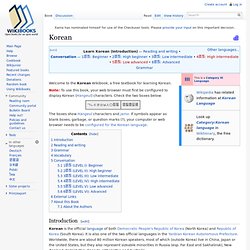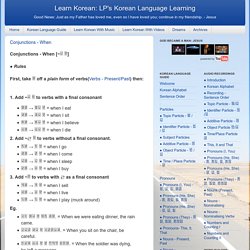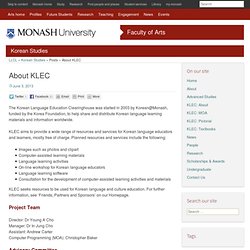

Talk To Me In Korean. Korean. Welcome to the Korean Wikibook, a free textbook for learning Korean.

Note: To use this book, your web browser must first be configured to display Korean (Hangeul) characters. Check the two boxes below: The boxes show Hangeul characters and jamo. If symbols appear as blank boxes, garbage, or question marks (?) , your computer or web browser needs to be configured for the Korean language. Introduction[edit] Korean is the official language of both Democratic People's Republic of Korea (North Korea) and Republic of Korea (South Korea). In the Republic of Korea, the language is most often called 한국말 (Han-gung-mal), or more formally, 한국어 (Han-gug-eo) or 국어 (Gug-eo; literally "national language").
Experts are still not completely sure of the origins of the Korean language, although it is generally believed to come from the Altaic language tree. The Korean Language Question And Answer Thread. I know there are some mixed attitudes about learning Korean amongst posters on Dave's but there seem to be a significant number of people here that take their Korean learning seriously.

Therefore this thread is an attempt to bring together everyone's questions and for others to help by answering them. So if you have questions such as 'How do you say X in Korean? ' or 'What is this Korean writing in English? ' post them in this thread and try to avoid starting new threads for questions. Let's centralize any questions and use it as a useful learning and reference source for everyone regardless of their Korean level, ranging from beginner to advanced.
Wherever possible try to keep posts short to encourage people to help. One question. For easy reference try to write questions in bold. I'll start with a question of my own... What does the grammar ㄹ/ㄴ/는 김 mean? -잖아 in Korean Grammar. View topic - Confusion of 하고, 와, and 과. Making Connections Lesson: Quote: 하고 - With, And하고 is the first one.

It actually has two uses. One is the word 'with', and the other is the word 'and'. Let's talk about the first use, 'with', first. If you were to say 나는 수비하고 먹어요, you would be saying 'I eat with Subi'. What's the following mean? Well, it's simply 'I am going home with Anna.' 하고 also means 'and', but only when it is meant to connect two nouns.
LP's Korean Grammar Guide: In a Living Room. Ask Korean language questions and get answers. Home : Korean Grammar Database. Know your Korean Grammar. Many experts have theorized as to the general structure and root of the Korean language. Most books will say that especially the Korean language grammar structure is generally similar to Altaic, and Japanese languages. They also share common language features such as vowel harmony, vocabulary, and lack of conjunctions.
= 경희대학교 국제교육원 IIE - 영문 = Learning Korean in Hong Kong (instead of Cantonese) God's Heart for North Korea. 아이엠코리언. Lee Gee Pum Video. 거야 korean grammar. LP's Korean Grammar Guide: Are you doing? - ~는 거야? [Informal] Are you doing?
![LP's Korean Grammar Guide: Are you doing? - ~는 거야? [Informal]](http://cdn.pearltrees.com/s/pic/th/informal-language-learning-54664006)
- ~는 거야? 는 거야 is commonly used in situations where you see somebody doing something and you want to ask them what they are doing. Again, 는 거야 can only be used when you are actually watching somebody doing something, and you want to ask them what they are doing. ● Rule Take 다 off a plain verb and add 는 거야? 하다 → 하는 거야? Eg.일 하는 거야?
Korean vocabulary, verb endings, forum, study links, grammar. Introduction to Korean. This tutorial requires a browser that complies with the standards established by the World Wide Web consortium.

Unfortunately, your browser is not one of them. If you wish to upgrade your browser, here are some suggestions. If you want to continue using your current browser (or are required to by your workplace or place of study), you may wish to go to the older version of this tutorial. Choose a topic: <hr /><p><b><span class="bigger attention">Note: these pages depend heavily on Javascript in order to function properly. Images of Seoul, a combination tourism guide and photo gallery. Downloading this tutorial to your computerSee the author’s Home Page Other Korean Links, Korean Textbooks, and Korea One Ring Thanks to Shin, In-Rae, the Korean teacher at Foothill College, who has made this material clear to me.
Thanks to Heather Lim for recording the sound for these pages. LP's Korean Grammar Guide: Conjunctions - When. Conjunctions - When [~을 때] ● Rules First, take 다 off a plain form of verbs(Verbs - Present/Past) then: 1.

Add ~을 때 to verbs with a final consonant 먹다 → 먹을 때 = when I eat앉다 → 앉을 때 = when I sit믿다 → 믿을 때 = when I believe죽다 → 죽을 때 = when I die2. LP's Korean Grammar Guide: Conjunctions - Because [때문에] Conjunctions - Because [때문에; 왜냐하면, 때문이다]
![LP's Korean Grammar Guide: Conjunctions - Because [때문에]](http://cdn.pearltrees.com/s/pic/th/conjunctions-language-learning-50614210)
Home : HomePage. Korean Language Education Clearinghouse (KLEC), Arts, Monash Uni. The Korean Language Education Clearinghouse was started in 2003 by Korean@Monash, funded by the Korea Foundation, to help share and distribute Korean language learning materials and information worldwide.

KLEC aims to provide a wide range of resources and services for Korean language educators and learners, mostly free of charge. Planned resources and services include the following: Korean Multimedia Dictionary. TV bigger than the world, iMBC.com.